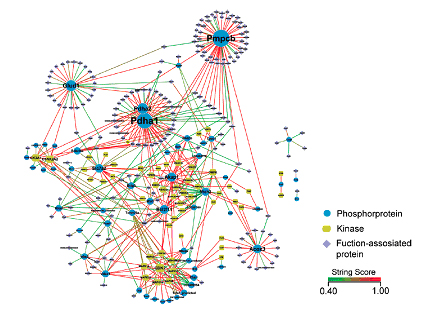The Profile of Mitochondrial Proteins and Their Phosphorylation Signaling Network in INS-1 β Cells
A paper published recently in the Journal of Proteome Research[1] combines the respective strengths of the labs of Professor Tao Xu and Professor Fuquan Yang in proteomics and insulin secretion to lay a foundation for investigating the role of mitochondria in pancreatic bcell insulin secretion.
Mitochondria are known to play important roles in cellular physiological functions and various diseases. In pancreaticcells, mitochondria play a central role in glucose-stimulated insulin secretion (GSIS). Mitochondrial dysfunction is thought to be causally correlated with an insulin-secretion defect of b cells in diabetes. Since different tissues and cells vary significantly in their mitochondrial functional requirements, and many mitochondrial proteins are tissue-specific, Professors Xu and Yang reasoned that it is crucial to obtain a comprehensive picture of the bcell mitochondrial proteome and phosphoproteome in order to understand the mechanisms regulating GSIS in physiological and diabetic states. They used shotgun proteomics to profile mitochondrial proteins and their potential phosphorylation sites in rat INS-1 cells. More than 800 proteins were assigned to mitochondria, and 84 different mitochondrial phosphoproteins were identified, while 52 upstream kinases of mitochondrial phosphoproteins were predicted using bioinformatics tools. Regulation networks of mitochondrial phosphoproteins were constructed by integrating mitochondrial protein interaction networks and mitochondrial phosphorylation signaling, providing a preliminary survey of how phosphorylation signaling regulates mitochondrial function in β cells.
The integrated resources generated by this study, including the protein composition and signaling pathways of mitochondria, will be of significant value for future research on the role of mitochondria in GSIS.

Figure. The interaction network of identified mitochondrial phosphoproteins, their interacting proteins and upstream kinases. Blue circles, yellow-green round rectangles, and purple diamonds represent mitochondrial phosphoproteins, their kinases, and the functional interaction proteins of the mitochondrial phosphoproteins, respectively.
[1] Ziyou Cui, Junjie Hou, Xiulan Chen, Jing Li,Zhensheng Xie, Peng Xue, Tanxi Cai, Peng Wu, Tao Xu, and Fuquan Yang (2010): The Profile of Mitochondrial Proteins and Their Phosphorylation Signaling Network in INS-1Cells. J Proteome Res. 9: 2898-2908.

